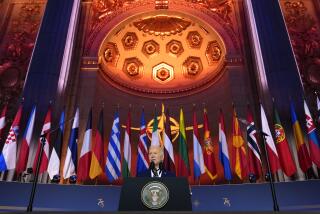NATO Ministers Urge Defense Budget Boosts
- Share via
BRUSSELS — Calling for growth in the defense budgets of the North Atlantic allies, NATO defense ministers on Friday struck a harmonious note at the conclusion of a two-day meeting of the alliance’s Defense Planning Committee.
But they warned that arms negotiations ahead could strain the allies’ unity as they try, according to U.S. Defense Secretary Dick Cheney, to “remake the military map of Europe.”
At the end of a meeting held every six months, NATO leaders acknowledged that disputes over which weapons would be covered by East-West negotiations in Vienna could slow progress toward an agreement limiting non-nuclear arms in Europe.
In particular, U.S. officials warned that both among the Western allies and between the North Atlantic Treaty Organization and Warsaw Pact alliances, disputes are simmering over which aircraft should be subject to limits in the Vienna negotiations.
“I’m not aware of (an issue) as complicated as the aircraft,” Cheney said after the meeting. “Our perceptions are so different.”
Limits on Combat Aircraft
In a surprising reversal, Washington agreed at the recent NATO summit to accept limits on NATO’s combat aircraft in return for much larger cuts in the warplanes of the Warsaw Pact.
The U.S.-conceived plan would reduce NATO’s force of 5,400 warplanes by 15%, to 4,600. In return, it calls for the Warsaw Pact to destroy at least 3,400 of its combat planes to reach the 4,600-aircraft mark.
But the decision has raised problems within the alliance that Cheney said had long discouraged the inclusion of aircraft. Among them are concerns that the proposed reductions would cut into the independent nuclear deterrent forces of Britain and France. Both countries operate large forces of strike aircraft capable of carrying nuclear weapons to Soviet territory. Most of those aircraft also could play roles during a non-nuclear war. In principle, they may therefore be subject to the NATO limitations.
In addition, the 15% cuts proposed by NATO could virtually wipe out the air forces of some of the smaller NATO nations, depending on how the aircraft reductions are apportioned within the alliance. That fear has been heightened by Washington’s insistence that in making reductions, NATO must keep its newest weapons--largely owned by NATO’s larger members--and retire older weapons. The bulk of the poorer allies’ forces--those of Turkey, for instance--are older aircraft.
The Soviets, too, have added to the dispute, arguing that the proposed limits should apply only to their force of offensive strike fighters. That definition would leave as many as 10,000 aircraft untouched by the agreement, including medium-range bombers and fighters, planes such as the MIG-29, the SU-24 and the Backfire bomber.
“What we’re after in terms of aircraft is parity,” said Cheney. “As long as you buy the Soviet definition of strike aircraft, we end up without parity.”
A NATO “high-level task force,” established by the defense ministers this week, is expected to work through the summer to hammer out agreements among the allies on the aircraft and other thorny negotiating issues. Until their work is complete, Cheney said, it is too early for the allies to discuss how the alliance would apportion cuts in its tanks, artillery, armored troop carriers and aircraft.
President Bush injected new urgency into the negotiating process by calling for NATO to reach an agreement in Vienna by September.
As defense ministers worked to maintain the sense of unity forged at the alliance’s May summit, they urged against scaling back budgets in anticipation of Soviet force reductions.
More to Read
Sign up for Essential California
The most important California stories and recommendations in your inbox every morning.
You may occasionally receive promotional content from the Los Angeles Times.











